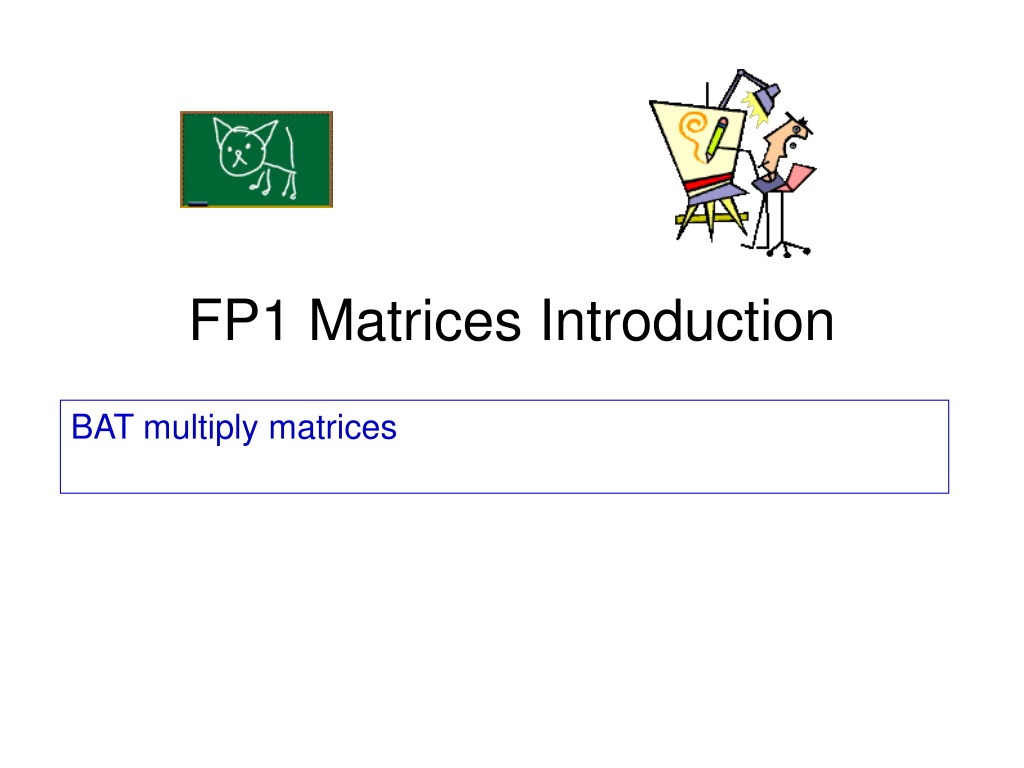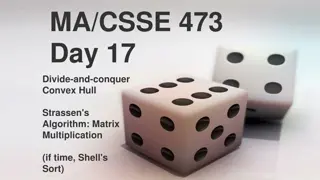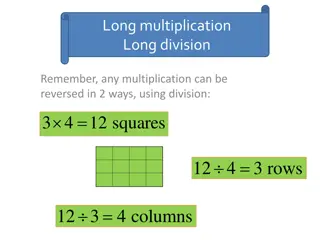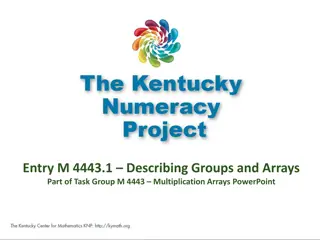Matrix Multiplication and Dimensions Guide
Learn how to multiply matrices, determine matrix dimensions, and distinguish between commutative and non-commutative operations. Gain insight into the practical application of matrix algebra with step-by-step examples.
Download Presentation

Please find below an Image/Link to download the presentation.
The content on the website is provided AS IS for your information and personal use only. It may not be sold, licensed, or shared on other websites without obtaining consent from the author.If you encounter any issues during the download, it is possible that the publisher has removed the file from their server.
You are allowed to download the files provided on this website for personal or commercial use, subject to the condition that they are used lawfully. All files are the property of their respective owners.
The content on the website is provided AS IS for your information and personal use only. It may not be sold, licensed, or shared on other websites without obtaining consent from the author.
E N D
Presentation Transcript
FP1 Matrices Introduction BAT multiply matrices
Matrix multiplication These numbers will give the dimensions of the answer ? ? = ? ? ? ? ? ? ? These numbers must be the same for the multiplication to be possible You multiply each row in the first matrix, by each column in the second matrix The product will have the same number of rows as the first matrix, and the same number of columns as the second
WB 7 ? =1 2 4 ? = 3 Find AB and BA 3 2 Dimensions for AB (2 x 2) x (2 x 1) = (2 x 1) 1 3 2 4 3 2 = To multiply matrices you first multiply corresponding elements of the rows and columns, then add them up (you ll get it with practice!) 1 3 + ( 2 2) 3 3 + (4 2) 3 + ( 4) Then once you have done all the columns, do the same thing, but using the second row 9 + (8) ?? = 7 After this, work out each part, and you then have the final matrix answer! 1 Dimensions for BA (2 x 1) x (2 x 2) = not possible
WB 8a ? = 1 0 3 ? =4 1 Find AB and BA 2 2 0 Calculating AB Dimensions for AB (2 x 2) x (2 x 2) = (2 x 2) 1 2 0 3 4 0 1 = 2 Multiply the first row by each column as in the previous example 1 4 + (0 0) 1 1 + (0 2) 2 1 + (3 2) 2 4 + (3 0) You always fill in the top row of the answer first 4 + (0) 1 + (0) 8 + (0) 2 + ( 6) A quick check you have probably done this correctly if the highlighted (green) numbers are the same! ?? = 4 1 4 8
WB 8b ? = 1 0 3 ? =4 1 Find AB and BA 2 2 0 Calculating BA Dimensions for BA (2 x 2) x (2 x 2) = (2 x 2) 4 0 1 1 2 0 3 = 2 Multiply the first row by each column as in the previous example 4 0 + (1 3) 4 1 + (1 2) 0 0 + ( 2 3) 0 1 + ( 2 2) You always fill in the top row of the answer first 4 + (2) 0 + (3) 0 + ( 6) 0 + ( 4) A quick check you have probably done this correctly if the highlighted (green) numbers are the same! ?? = 2 3 4 6 AB ?? Multiplication using matrices is NOT commutative This means the order of multiplication does matter as a different order gives different answers!
WB 9abc Find a) AB 2? =4 2? = 3 ? = 1 1 5 b) BC c) CA d) BCA AB = dimensions (1x3) x (1x2) not possible As the central numbers are not equal, these matrices cannot be combined 4 5 = BC = 3 12 + ( 10) = 2 2 2 = 4 1 4 1 5 1 4 2 5 2 CA = 4 1 1 5 1 5 = 4 4 5 8 10 5
WB 9d Find a) AB 2? =4 2? = 3 ? = 1 1 5 b) BC c) CA d) BCA Calculating BCA This can be done in one of two ways 1) (BC)A Multiply B by C, and the answer to that by A (in that order) (1) ?? = 2 ??? = 2 1 1 2 2) B(CA) Multiply C by A, and multiply B by the answer to that (in that order) ??? = 2 2 4 4 4 5 8 10 (2) ?? = 5 Remember you cannot change the order, so for method 2, do not do CA and then x B after, the B must go at the front! 4 4 5 8 ??? = 3 2 5 10 ??? = 2 2 4
Matrices - multiplying WB 10abcd Use each row of the first matrix with each column of the second matrix. The result gives you the element in row a column b of the product matrix. 1 0 2 1 3 4 2 3 5? =3 2? = 3 8 2 4 0 ? = 2? = 1 1 1 Find (where possible): i) AB v) DA ii) BA vi) AD iii) BC vii) CD iv) CB viii) DC 2 3 5 3 1 8 9 2 10 18 AB = 2 = 1 2 3 5 = BA =3 8 2 4 49 7 1 1 2 BC =3 8 3 1 2 4 0 2 = 1 38 6 16 4 1 2 5 CB = 3 2 4 0 3 1 8 2= not possible 1 2 To multiply matrices what must be true?
Matrices - multiplying WB 10ef Use each row of the first matrix with each column of the second matrix. The result gives you the element in row a column b of the product matrix. 1 0 2 1 3 4 2 3 5? =3 2? = 3 8 2 4 0 ? = 2? = 1 1 1 Find (where possible): v) DA vi) AD vii) CD viii) DC 2 3 10 10 6 8 1 0 2 1 3 4 3 1 8 DA = 2 = 1 0 2 1 3 4 AD =3 8 = not possible 1 2 BC =3 8 3 1 2 4 0 2 = 1 38 6 16 4 1 2 5 To multiply matrices what must be true?
Matrices - multiplying WB 10gh Use each row of the first matrix with each column of the second matrix. The result gives you the element in row a column b of the product matrix. 1 0 2 1 3 4 2 3 5? =3 2? = 3 8 2 4 0 ? = 2? = 1 1 1 Find (where possible): v) DA vi) AD vii) CD viii) DC 1 0 2 1 3 4 3 3 9 3 CD = 3 2 4 0 = 1 2 1 0 2 1 3 4 4 3 2 2 12 20 2 3 1 2 4 0 DC = 2 = 6 8 To multiply matrices what must be true?
WB 11 ? =1 Given that BA = (0), show that AB= 2? ? = ? 2 ? 2 2? 2?2 1 ? = ? + 2? ?? = ? 2 As BA = 0, the implication is that b + 2a = 0 ? + 2? = 0 2? = ? ?? = 1 ? ?? 2 2? 2 = ? We know from before that 2a = b so we can replace the b terms ? ?? = 2? 2 2? 2?2
Summary Crucial points: Make sure that you can do matrix multiplication confidently Remember that matrix multiplication is NOT commutative AB BA























